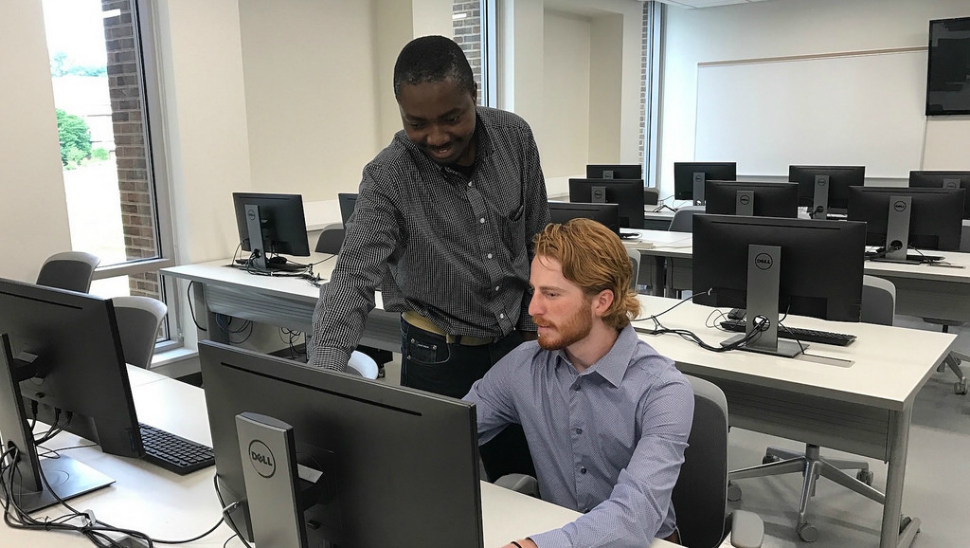Scott Smith, June 4, 2017
While the goals of western Pennsylvania?s farmers may not have changed significantly in the past few decades – raise healthy crops and sell them at a good price – the tools available to do so have.
Like other Big Ten schools, Penn State has been on the forefront of bringing technological advancement to agriculture whether through fast farming, mushroom crops or mobile apps.
The latter area is a focus for Richard Lomotey, assistant professor of information sciences and technology at Penn State Beaver and Senior IST major Evan McStay (pictured above). Based on some initial designs from McStay and insights from Lomotey?s previous expertise in creating apps, the duo recently received a $2,000 Penn State Student Engagement Network Grant to create a mobile app that helps farmers identify and treat crop diseases.
Some of Lomotey?s previous work has been based in Canada where farmers are given a book to help them identify crop diseases based on their specific province. ?Now, truth being told, nobody goes to a farm carrying a book,? he says with a laugh. ?So the intervention here is to build a mobile application farmers can carry with them.?
Lomotey talked with LiveBIG about plans for the app, how they modified their previous work to reflect their western Pennsylvanian location and why those in high-tech should look for more opportunities in agriculture.
BTN LiveBIG: What does the app do exactly?
Richard Lomotey: The app is to help farmers identify crop-related diseases and use the mobile intervention to determine what pesticide or fungicide to apply as far as the treatment is concerned. There are just no products out there that are convenient for farmers to use as far as doing assessment of their crops. We have images in there of the various crops for identification and the type of diseases that affect crops in western Pennsylvania. And, of course, the types of chemicals they have to use.
BTN LiveBIG: The initial app was created to identify and diagnose plants in Ghana. What changes did you have to make for this one?
Richard Lomotey: Oh, a lot! The specific case for Ghana, we focused on one specific crop, which is cocoa. Coming to western Pennsylvania, the crops are completely different – coca is not grown here.
There are things that make the product here different, but we are focused on connecting farmers. So let?s say [there?s] a farmer in Ohio, a farmer in Youngstown and a farmer in the Pittsburgh area. Because we are in the same area, in a crop season you?ll be affected with similar types of crop diseases compared to people in Texas or Arizona. So we created a social media forum within this product that farms can use to express themselves, share their experiences and upload images of their products.
BTN LiveBIG: What don?t most people understand about the way farmers use technology?
Richard Lomotey: Modern agriculture technology is driven by technology in several ways. These days farmers can use mainstream technology like the Internet of Things to engage in precision farming or ?smart farming.? So farmers are able to use sensors to measure the acidity of the soil, farmers are able to use mobile technology to promote their sales, to reach the market easily, to check on weather forecasting. Farmers are heavily using all types of communicating devices just like any enterprise.
So we?re still looking at the farmer as someone who is growing a crop instead of looking at the workflow the farmer uses and see how we can provide technological interventions to streamline the workflow for the farmer.
BTN LiveBIG: Why is Penn State a good place to do this kind of work?
Richard Lomotey: Penn State supports community connections. If you are here and doing research work, one of the critical questions has to do with ?Who benefits from it?? because we are community oriented. So Penn State will sponsor the work financially because it directly impacts the life of farmers within western Pennsylvania.







 See what's coming up live on B1G+ every day of the season at BigTenPlus.com.
See what's coming up live on B1G+ every day of the season at BigTenPlus.com. 